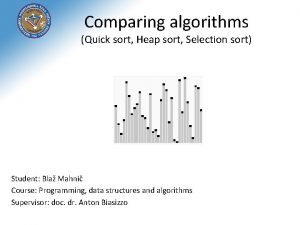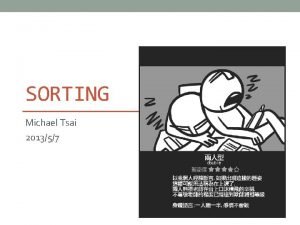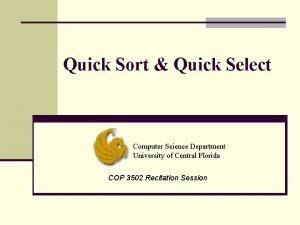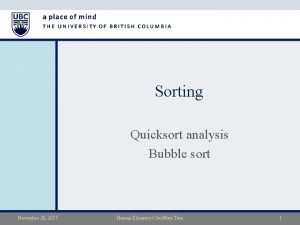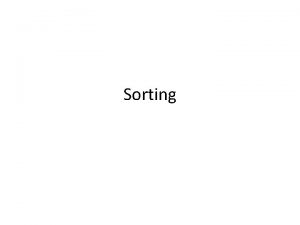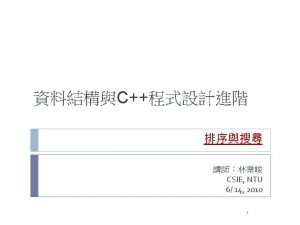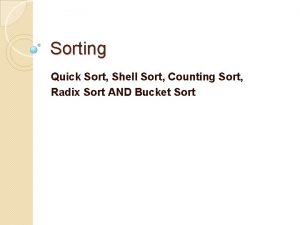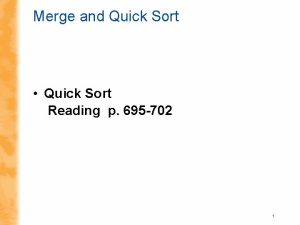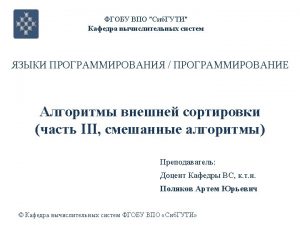Quick Sort Quick Select Computer Science Department University










- Slides: 10

Quick Sort & Quick Select Computer Science Department University of Central Florida COP 3502 Recitation Session

The Selection Problem n Given an integer k and n elements x 1, x 2, …, xn, taken from a total order, find the k-th smallest element in this set. n Naïve solution - SORT! n we can sort the set in O(n log n) time and then index the k-th element. 7 4 9 6 2 2 4 6 7 9 k=3 n Can we solve the selection problem faster? Quick Sort & Quick Select page 2

The Selection Problem n Can we solve the selection problem faster? n n Of course we can! We use Quick Select n What is Quick Select? n n Concept is very similar to Quick Sort But in this case, we are not sorting We don’t care about sorting the numbers BUT, we do care about finding the specific element Quick Sort & Quick Select page 3

Quick-Select n Quick-select is a randomized selection algorithm based on the prune-and-search paradigm: n Prune: pick a random element x (called pivot) and partition S into n n x L elements less than x E elements equal x G elements greater than x Search: depending on k, either answer is in E, or we need to recur on either L or G x L k < |L| E G k > |L|+|E| k’ = k - |L| - |E| |L| < k < |L|+|E| (done) Quick Sort & Quick Select page 4

Partition n We partition an input sequence as in the quick-sort algorithm: n n We remove, in turn, each element y from S and We insert y into L, E or G, depending on the result of the comparison with the pivot x n Each insertion and removal is at the beginning or at the end of a sequence, and hence takes O(1) time n Thus, the partition step of quick-select takes O(n) time Algorithm partition(S, p) Input sequence S, position p of pivot Output subsequences L, E, G of the elements of S less than, equal to, or greater than the pivot, resp. L, E, G empty sequences x S. remove(p) while S. is. Empty() y S. remove(S. first()) if y < x L. insert. Last(y) else if y = x E. insert. Last(y) else { y > x } G. insert. Last(y) return L, E, G Quick Sort & Quick Select page 5

Quick-Select Visualization n An execution of quick-select can be visualized by a recursion path n Each node represents a recursive call of quick-select, and stores k and the remaining sequence k=5, S=(7 4 9 3 2 6 5 1 8) k=2, S=(7 4 9 6 5 8) k=2, S=(7 4 6 5) k=1, S=(7 6 5) 5 Quick Sort & Quick Select page 6

Running Time n Best Case - even splits (n/2 and n/2) n Worst Case - bad splits (1 and n-1) 7 2 9 43 7 6 19 7 1 1 2 4 3 1 1 Good call 7294376 Bad call Quick Sort & Quick Select page 7

Expected Running Time n Consider a recursive call of quick-select on a sequence of size s n n Good call: the sizes of L and G are each less than 3 s/4 Bad call: one of L and G has size greater than 3 s/4 7 2 9 43 7 6 19 7 1 1 2 4 3 1 1 Good call n 7294376 Bad call A call is good with probability 1/2 n 1/2 of the possible pivots cause good calls: 1 2 3 4 5 6 7 8 9 10 11 12 13 14 15 16 Bad pivots Good pivots Quick Sort & Quick Select Bad pivots page 8

quick. Select Summary n Recall: the Selection problem n Find the kth smallest element in an array a n quick. Select(a, k): 1. If a. length = 1, then k=1 and return the element. 2. Pick a pivot v a. 3. Partition a – {v} into a 1 (left side) and a 2 (right side). • • • if k a 1. length, then the kth smallest element must be in a 1. So return quick. Select(a 1, k). else if k = 1 + a 1. length, return the pivot v. Otherwise, the kth smallest element is in a 2. Return quick. Select(a 2, k - a 1. length - 1). Quick Sort & Quick Select page 9

Quick Sort & Quick Select Computer Science Department University of Central Florida COP 3502 Recitation Session
 Heap sort vs selection sort
Heap sort vs selection sort Quick sort merge sort
Quick sort merge sort Quick sort merge sort
Quick sort merge sort Quick select sort
Quick select sort Columbia university department of computer science
Columbia university department of computer science Bubble sort vs selection sort
Bubble sort vs selection sort Difference between insertion sort and bubble sort
Difference between insertion sort and bubble sort Sorting pseudocode
Sorting pseudocode Insertion sort vs selection sort
Insertion sort vs selection sort Bubble sort insertion sort
Bubble sort insertion sort Differentiate between bubble and quick sorting
Differentiate between bubble and quick sorting
